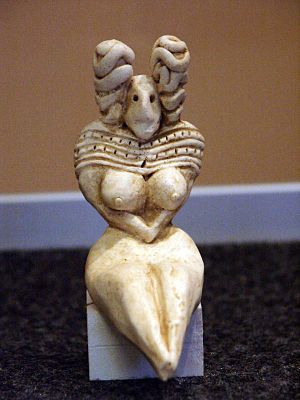Mehrgarh

Mehrgarh was a prehistoric settlement group in South Asia and one of the most important archaeological sites of the earliest Neolithic in this region. The remains were found in Balochistan ( Pakistan ) on the Kachi Plain near the Bolan Pass , west of the Indus Valley and between the present-day cities of Quetta , Kalat and Sibi .
Mehrgarh is considered to be the first known agricultural settlement in South Asia. First excavations were carried out in 1974. The earliest signs of settlement date from around 7000 BC. Chr . The earliest pottery in South Asia was also found here. The archaeologists could distinguish between several periods.
Mehrgarh I
The Mehrgarh I phase lasted from about 7000 to 5500 BC. BC and was an akeramisches Neolithic , d. H. without making pottery . The first fields in the area were created by semi- nomads who grew wheat and barley and raised sheep , goats and cattle . They built simple buildings out of dried mud that were divided into four "rooms". Numerous burials were found, as well as very advanced utensils such as baskets, tools made from stone and bone material, jewelry such as pearl necklaces, bracelets, pendants and occasionally animal sacrifices. Amazingly, some of these victims found more grave goods than human burials. Jewelery made from sea shells , limestone , turquoise , lapis lazuli , sandstone and polished copper were found, as well as simple figurines of women and animals. A single find was a cut stone ax as an addition to a burial - the first such find on the Indian subcontinent - a few more remained on the surface of the earth at that time.
Mehrgarh II and III
Mehrgarh II (about 5500-4800 BC) and Mehrgarh III (about 4800-3500 BC) then already belong to the ceramic Neolithic (pottery was therefore in use) and the Copper Age . There was much evidence of advanced manufacture with improved techniques. Glazed pearls ( faience ) were produced as well as terracotta figures with more and more details. Figures of women were painted and had different hairstyles and ornaments. Red ocher was found on the bodies of those buried in two graves from the Mehrgarh II period . The number of grave goods gradually decreased. The first seals made of terracotta and bone material with geometric motifs were made. The technology now included copper drills , kilns with updraft technology and crucibles . On the basis of finds of lapis lazuli, which, according to investigations, came from Badakhshan , long-distance trade can already be seen as proven in Mehrgarh II.
Mehrgarh IV
The ceramic of this stage (around 3500 BC) is often brightly painted. Clay figures appear, but they still seem quite clumsy.
Mehrgarh V
The clay figures are refined, which is due to a finer clay and higher firing temperatures. The figures are cream-colored. Some of the ceramics are still painted in bright colors. Around 3000 BC The same clay figures also occur in southern Central Asia, including in Sarasm and Kara Depe (near Namazgadepe ).
Mehrgarh VI
This stage belongs to the Bronze Age. There are still clay figures that are now particularly imaginative, new stone tools, such as arrowheads retouched on both sides appear. Geometrically decorated stamp seals are also popular at this level. Sometime between 2600 and 2000 BC The place was abandoned after a while, probably by other people.
Mehrgarh VII
Mehrgarh VII is best known from graves that were found on the southern burial ground. The place seems to have been uninhabited for a while. The new culture is strongly influenced by Iran, but also has close ties to the Indus culture . Most of the burials were poorly preserved, but still contained numerous objects. The skeletons were mostly found in a bent position. There were also ceramics such as cups, metal objects, stone objects, jewelry and seals. Noteworthy are some staffs that can perhaps be interpreted as scepter. In addition, objects of the Indus culture appear in the graves, such as an amulet with the Indus script .
literature
- Forgotten cities on the Indus. Early cultures in Pakistan from August 8th to 2nd Millennium BC Chr. Philipp von Zabern, Mainz 1987, ISBN 3805309570 , pp. 67–111 (six articles on the location)
- Catherine Jarrige: The figurines of the first farmers at Mehrgarh and their offshoots. Paper presented in the International seminar on the "First Farmers in Global Perspective". Lucknow, (India) 18. – 20. January 2006
Web links
Individual evidence
- ↑ Catherine Jarrige, p 162
Coordinates: 29 ° 24 ' N , 67 ° 36' E
